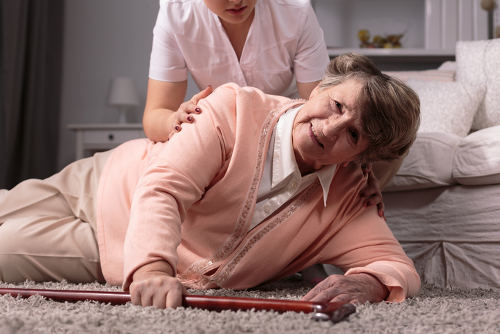 You might not think of falls as particularly threatening or preventable, but they are. Preventing a fall could be extremely important in maintaining your current quality of life and health, and may even save your life. One out of every five falls causes a serious injury like broken bones or a head injury, according to the Centers for Disease Control and Prevention (CDC).
You might not think of falls as particularly threatening or preventable, but they are. Preventing a fall could be extremely important in maintaining your current quality of life and health, and may even save your life. One out of every five falls causes a serious injury like broken bones or a head injury, according to the Centers for Disease Control and Prevention (CDC).
Fall prevention, however, is often an afterthought among those in the aging population. It’s also a step most don’t want to take because, quite simply, they don’t know what to do.
Falling is typically viewed as an accident, and it is—to an extent. Nobody plans on falling down the stairs, tripping on the sidewalk, slipping on ice, or losing their balance getting out of the easy chair. But how your body handles impact and your ability to stay upright can make all the difference in the world, and guess what? Those are things you can control.
You can also control your environment to help protect you from falling. Where you store certain items, how your home is designed, and whether you use mobility assistance items can all play a role in your risk factor for a fall and your level of protection.
The Risks of Falling
According to data collected by the CDC, millions of Americans 65 and older fall every year. But it’s reported that less than half of those who fall tell their doctor, and falling once doubles your chances of subsequent falls.
Here is some data worth considering:
- About 2.8 million older Americans (65+) are treated in the emergency room each year for fall-related injuries.
- Each year, more than 800,000 patients are hospitalized because of a fall injury, often due to a head injury or hip fracture.
- At least 300,000 older people are hospitalized for hip fractures yearly.
- Over 95% of hip fractures are caused by falling, most often because of falling sideways.
- Falls are the most common cause of traumatic brain injuries (TBI).
- Falls can cause broken bones like wrist, arm, ankle, and hip fractures
- Falls can cause head injuries, which can be very serious if taking blood thinners.
- Many people who fall, even if they are not injured, become afraid of falling again. This can result in cutting down on everyday activities, lowering quality of life. Lowered activity translates into weaker muscles that increase the chance of falling.
 Conditions That Make You Likely to Fall
Conditions That Make You Likely to Fall
- Weakness in the lower body
- Poor balance
- Low vitamin D levels
- Vision problem
- Taking certain medications like sedatives or antidepressants
- Poor footwear
- Home hazards like uneven steps, throw rugs, clutter, lack of handrails
How to Prevent Falls and Improve Balance
Fall prevention really comes right down to choices you make every day and the lifestyle you lead. And these choices by no means guarantee you won’t fall, but they can lower the chance of a fall and limit the injuries you might experience.
Exercise and strong muscles play a big role in fall prevention. The more muscle you have, the more durable your body is and the better job it can do to keep you balanced. Therefore, activity is central to fall prevention. If you’re strong enough to maintain footing or not be thrown off balance from unexpected impacts, you’re ahead in the game. We’ll look a few specific practical exercises shortly, but for the most part, it’s important to be aware that activity reduces the risk, and being sedentary increases the risk of an injury from a fall.
Diet also plays an important role in your susceptibility for a fall. First off, you want to make sure you’re eating enough food so you’re feeling strong and alert, not weak and dizzy. Eating food high in protein is recommended because it encourages muscle and cell growth, helping to increase and maintain strength. There are also specific nutrients like vitamin D, calcium, and others that may help increase balance and resilience.
Lastly, you can prevent falls by making sure items like throw rugs aren’t in the picture. The corners are easy to trip on, making them a significant risk factor. Keeping your house free of clutter, keeping corners clear, and making sure the items you use every day are easily accessible can also reduce the risk. Installing railings around stairs, in the bathroom, and anywhere else needed can also be a big help.
Exercises to Reduce the Risk of Falling
Although overall strength is best and adopting ways to exercise the whole body is recommended, there are some specific exercises that can help reduce the risk of falling. These exercises focus on lower body strength, balance, and agility.
1. Squats
The best, and most practical, exercise for lower body strength is the squat. Squatting is essentially the same movement you make every day when you get out of a chair or off the toilet. Adding some resistance to the movement will improve strength and muscularity.
To perform a squat, place a chair or ottoman behind you. For balance purposes, stretch out your arms in front of you at shoulder level. With your feet firmly planted on the ground, slowly bring your hips back so your knees bend. Bend your knees so they do not cave in, instead aligning them directly over your foot or pointing slightly outward. When you feel your bum contact the chair or ottoman, push your feet into the floor so your legs extend and you return the standing position.
You should focus on contracting the muscles in your upper leg and feel it from your butt almost to the back of your knee in the rear (glutes and hamstrings), and from above the knee to almost your hip in the front (quadriceps).
2. Side to Sides
For this exercise, you’ll want to put on a pair of sneakers and make sure they are tied up tightly enough. Clear a space on the floor, in the garage, or on the driveway, and arrange some items on the ground between six and 10 feet away from each other. Arrange four or six items in a box shape; then, walk over to one, pick it up, and carry it over to another space. Do a few rotations with sidesteps and regular walking, switching the patterns you move through the box. This will help with balance and agility because you’ll be changing directions and improving lateral mobility.
Tai Chi is also a great way to improve balance, agility, and improve the mind-muscle connection.
Foods That Can Help Improve Balance
As noted, certain nutrients can aid in balance and durability. Vitamin D is an important nutrient and is associated with fall risk, so it’s important to make sure you’re getting enough. Because the best source of vitamin D is natural sunlight, it can be very hard to get—especially in cooler temperatures. You can supplement with vitamin D, while also trying to eat foods like
- Salmon
- Fortified cereals and grains
- Fortified orange juice
- Fortified fish oil supplements
Protein is also highly important to build and maintain muscle mass, while also promoting satiety. Some great sources include:
 Chicken breast
Chicken breast- Eggs
- Egg whites
- Turkey breast
- Flank steak
- Wild boar
- Sirloin steak
- Game meat
- Legumes
Doing What You Can to Prevent Falls
A potential fall could be waiting on the other side of every step, and it’s virtually uncontrollable. However, you can do things to regain balance and limit the risk and dangers of a fall. Doing your best to protect yourself from a fall is highly recommended and can provide a number of additional health benefits, too. Lastly, if you do fall, visit your doctor immediately.
Related:
- Vitamin D Deficiency in the Winter: Health Effects & Supplementation
- Burdock Root: Nutrition Facts, Health Benefits, and Recipes
- 10 Surprising Health Benefits of Drinking Hot Water Every Day
- Does a Colon Cleanse Benefit Your Health?
Sources:
“Important Facts about Falls” CDC, September 20, 2016; https://www.cdc.gov/homeandrecreationalsafety/falls/adultfalls.html, last accessed February 8, 2017.
